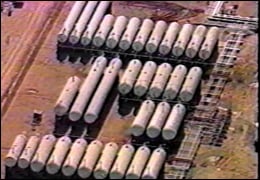Trouble in Texas
A husband and wife chatted as they passed an energy plant in north Texas
“I hate to be that way, but if it has to be…” the wife said matter-of-factly after she and her husband realized that blowing up the natural gas processing facility would kill many people, including young children at a nearby school.
The year was 1997. The couple belonged a regional extremist group called the True Knights of the Ku Klux Klan and was casing the plant for a Klan operation. Along with two other True Knights, their plan was to build a homemade bomb—like the one used in Oklahoma City two years earlier—and explode it near large storage tanks at the facility. They hoped that the resulting explosion would release a cloud of hydrogen sulfide—so-called “sour gas”—that would kill hundreds of people. The children were just collateral damage.
As grisly as that sounds, it was just the beginning of their plan. The bombing was simply a cover to distract law enforcement while the Klan robbed an armored car of some $2 million on the other side of town. In fact, to add to the chaos and help clear the way for the robbery and getaway, the plot called for detonating a second bomb when law enforcement and first responders arrived at the scene of the explosion.
And the point of the robbery? To raise money to go to war with the U.S.
It was no idle talk. “They were building and testing improved explosive devices,” says Special Agent John Fraga, who led the Operation Sour Gas investigation while supervising our North Texas Joint Terrorism Task Force and is now the acting head of the Terrorist Explosive Device Analytical Center
What the Klan members didn’t know was that the FBI office in Dallas
With plenty of evidence in hand, we arrested all four conspirators in April 1997 before they could carry out their sinister plot. Each pled guilty by early October and was ultimately sentenced to jail.
“This case was one of the Bureau’s first weapons of mass destruction preventions,” says Fraga. And it was yet another successful victory in the FBI’s fight against the KKK, which started in the years prior to World War I and continues to this day.
Over that time, the Klan has continued to morph and change. Today, it’s a shadow of its brazen, lawless self in the 1950s and 1960s—thanks in large part to the dogged work of the FBI and its partners during that era—but as the Texas case demonstrates, the threat remains.
As always, the FBI remains committed to protecting the civil rights of all Americans—whether from crimes of hatred or acts of terror—carried out by the KKK and like-minded extremists. Look to this website in the future for more news and information on this continuing effort…







No comments:
Post a Comment